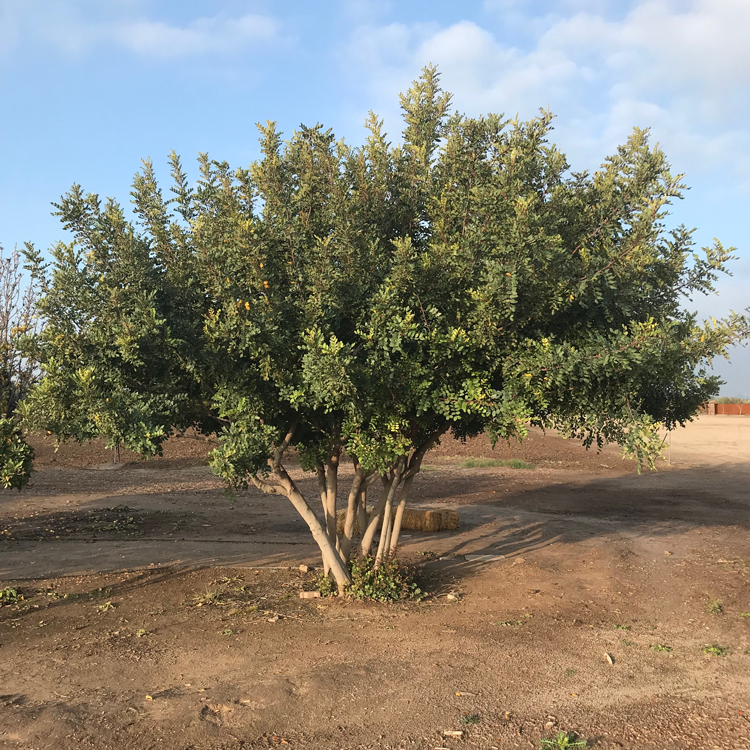Wearing a camel-hair garment and a leather belt is one thing but eating locusts and wild honey is another!
I don’t suppose John the Baptist was wearing the camel hair garment that I am familiar with – although I think it would certainly have given an ecumenical advantage with the Brooks Brothers crowd – of whom I have been a sometimes admirer!

No, the intent of the gospel writers-particularly St. Matthew and Saint Mark-was clear. John was clearly eschewing the comfortable garments of the rich and was purposely wearing some incredibly uncomfortable garment like the one this artist imagined.

But as if that wasn’t enough of a mortification let’s focus a little on his diet!
Here is what St Matthew wrote which, incidentally, my rudimentary knowledge from teaching elementary Greek to high school students has given me just enough facility to handle.
ἡ δὲ τροφὴ ἦν αὐτοῦ ἀκρίδες καὶ μέλι ἄγριον.
My translation:
And the food/nourishment/maintenance (τροφὴ) was of him (αὐτοῦ) locusts (ἀκρίς, ίδος, ἡ) and wild (ἄγριον) honey (μέλι, ιτος, τό)
Or I suppose one might say,
And his food was locusts and wild honey.
The Douay Rheims gets a little creative when it translates the same verse from Latin,
esca autem ejus erat locustæ, et mel silvestre
rendering it thusly,
and his meat was locusts and wild honey.
I suppose locusts or grasshoppers might be meaty underneath those brittle exoskeletons. Yuck!

Now back to the question. We all know that scripture is the word of God and therefore we need to take every word seriously.
But remember! We need to start with the literal sense of the words (in scripture) before we proceed to any spiritual signification. So, the bottom line here-the literal sense is that- yes, John the Baptist actually appears to have eaten locusts and wild honey. The Greek and the Latin are just too clear. Besides, we also have this solid well-substantiated and irrefutable evidence from Wikipedia concerning the eating of locusts!
They are also edible insects; they have been eaten throughout history and are considered a delicacy in many countries.
![]()
Yum!
I am completely convinced.
So, let’s move on from the literal meaning. We need not entertain further any notion that the locusts that John the Baptist ate were really something else – like Locust Bean Gum extracted from the seeds of the carob tree!

No! St. Matthew and St. Mark were perfectly aware that they were relating something that would shock their readers. They knew that anyone hearing about John’s diet would probably be impressed at the strength of his resolution- despite any considerations concerning just how scrumptious locusts might be. Besides, no reader is really interested in carob trees! Pshaw!
The literal meaning of the verse is clear. Let us proceed to the even meatier spiritual senses.
And to what source do we turn when we wish to plummet the depths of the Gospel a little more deeply?
Why – St. Thomas’ Catena Aurea of course!
As usual St. Thomas is too kind to satiate our appetites with locusts. Instead, like the intellectual bee he was, he gathered up all the honey from the various fathers and doctors of the church and has spread it all out for us his students! (note well! that in the ‘flight’ of my poetic simile I did not compare you, my dear reader, to the drones back in the hive!)

Listen to what St. Gregory says about this passage commenting on St. Mark’s account,
…by the kind itself of his food he pointed out the Lord, of whom he was the forerunner; for in that our Lord took to Himself the sweetness of the barren Gentiles, he ate wild honey. In that He in His own person partly converted the Jews, He received locusts for His food, which suddenly leaping up, at once fall to the ground. For the Jews leaped up when they promised to fulfil the precepts of the Lord; but they fell to the ground, when …they affirmed that they had not heard them. They made therefore a leap upwards in words, and fell down by their actions.
In other words, John points to the Lord who came to earth in order to draw everyone unto Himself. This has a comparison to eating in which food is drawn into the one who eats and is, in fact, made to become one with the one who eats.
Another commentator, the blessed Theophylactus, the eleventh-century Byzantine exegete has this to say,
The food also of John not only denotes abstinence, but also shews forth the intellectual food, which the people then were eating, without understanding any thing lofty, but continually raising themselves on high, and again sinking to the earth. For such is the nature of locusts, leaping on high and again falling.
This reminds me of Our Lord’s answer to his disciples when they asked Him why he taught in parables,
Why speakest thou to them in parables? Who answered and said to them: Because to you it is given to know the mysteries of the kingdom of heaven: but to them it is not given…because seeing they see not, and hearing they hear not, neither do they understand.
Blessed Theophylactus continues,
In the same way the people ate honey, which had come from bees, that is, from the prophets; it was not however domestic, but wild, for the Jews had the Scriptures, which are as honey, but did not rightly understand them.
It appears to me that Blessed Theophylactus is comparing the prophets to bees, which seems like an apt comparison. Bees go busily about, sometimes stinging people, but ultimately their work is to bring sweetness and honey!

But insofar as the “honey” of the scriptures is not understood – it is foreign and therefore is wild. In other words, Theophylactus is saying that this wild honey- the scripture misunderstood by the Jews, was the food of John the Baptist.
So, of course, John the Baptist ate locusts and wild honey! What else would he eat?




The squeamish among us really want it to be a bean.
A priest at my church preached about this yesterday during his homily saying his Protestant friend was the one who “taught” him that John the Baptist ate figs that were called locusts during this time. I need to tell him to forget about his Protestant friends and do some research before listening to and preaching on what they say. Thanks so much for succinctly answering my own inquiries into the information he preached about.
My research also tells me that locusts are an excellent source or protein whereas figs not so much 🙂
All City Candy on Richmond Road sells some species of orthoptera which I’ve often thought would be an appropriate snack for certain liturgical feasts. At the moment, I cannot rightly recall whether the species is a true acridida are merely gryllidae (crickets) – authenticity is important. Um, it’s also good to check the expiration date.
What an excellent suggestion. Let’s establish this as the formal snack for the feast of John the Baptist- or at least the second sunday of Advent. Thanks for the tip on All City Candy!
In the late Herman Wouk’s introductions to Judaism, THIS IS MY GOD, he says that there was a certain species of locusts that WERE permissible as food for observant Jews.
Then again, it might have been a kind of nut called a locust.
It’s not an issue I stay up late nights worrying about.
I once helped get about 6 + Ethiopian guys jobs in my area of SF Bay Area,CA. and some how we had a conversation about John the Baptist and the locust’s that he supposedly ate. I have no idea how the conversation came up, but one of the Ethiopians said that in Ethiopia people used to eat such food, but in the following way: They cleaned the locusts and put them into jars of honey to store them for a long time. They would therefore have a source of both simple carbohydrates and protein which could last years in storage.
Made sense to me, at that time. And still does.
Not too many locusts in my area, though..otherwise I would try it out.
Why not?
I think it is ingenious ‘survivor’ food. 50% honey and 50% cleaned Locusts would be a good place to start. 🙂
Wikipedia is interesting on this verse: https://en.wikipedia.org/wiki/Matthew_3:4
Quote: ‘The description of John the Baptist’s clothing is believed by most scholars to be a deliberate echo that (sic) of the prophet Elijah, who in 2 Kings 1:8 is said to wear “a garment of hair and with a leather belt around his waist.” Unquote.
Such a garment would likely have been of goat hair, according to Wiki, the garment of the ascetic, and it is possible that the writer of Matthew’s Gospel was simply mistaken in referring to “camel” hair which would have been quite a luxurious fabric for protection against the sun in the desert.
But the link above from 2 Kings 1:8 gives, not “a garment of hair” but “A hairy man, with a leather belt around his waist”. However, the Septuagint reads: ἀνὴρ δασὺς καὶ ζώνην δερματίνην περιεζωσμένος τὴν ὀσφὺν αὐτοῦ which better translates “A hairy man and girt about his loins with a leather belt.” ὀσφὺν is usually taken to mean loins in the LXX and the NT. In classical Greek it means the lower part of the back. The Vulgate has “vir pilosus et zona pellicia accinctis renibus”, renibus meaning kidneys in classical Latin and again loins in the OT.
I suspect that the source for the Wiki reference to Elijah’s “garment of hair” (Albright, W.F. and C.S. Mann. “Matthew.” The Anchor Bible Series.) has carefully Bowdlerised the LXX for two reasons: firstly, to put some clothes on Elijah, when he may actually have been naked, apart from the belt; secondly to provide an apparent source for Matthew’s description, given his proclivity for showing the Gospel story as the fulfilment of OT prophecies. I need someone with Hebrew to tell me what the original says.
None of this has to do with locusts and wild honey, which I was going to write about. Maybe next post.
Depths are not plummeted; they are plumbed! People plummet to their deaths!
Thanks Father Mitchell. I am going to make that edit asap!
I believe that he did actually eat locusts and wild honey, but not only those things. His diet and attire show that he was not wealthy and was a man who liked the wilderness.
Bible was straight with its contents of what he ate. Locust is locust. Wide honey is wide honey bread bread and fish fish nothing to twist you people should stop writting this contrary to the scripture
Thanks! I agree with you entirely that John actually ate locusts and wild honey as scripture plainly attests. In the article I say,
“…We need to start with the literal sense of the words (in scripture) before we proceed to any spiritual signification. So, the bottom line here-the literal sense is that- yes, John the Baptist actually appears to have eaten locusts and wild honey. The Greek and the Latin are just too clear.”
So this article is merely an attempt to gain something more from Holy scripture. Is it possible that the locusts and wild honey that John certainly did eat – might also have had a spiritual significance?